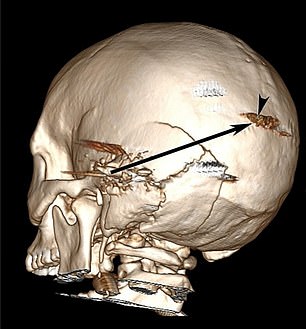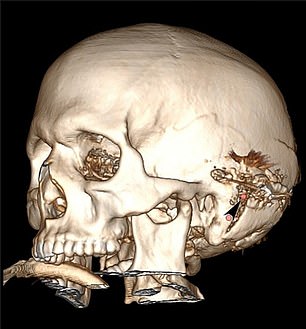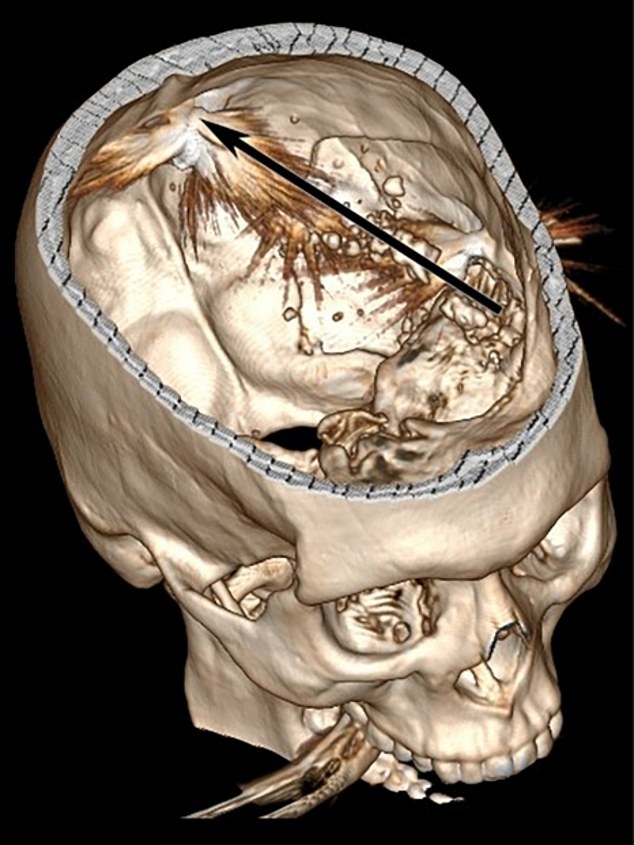Doctors have revealed the bittersweet case of a man who survived being shot in the head from close range.
The 29-year-old farmer from the Greek island of Crete was shot with a pistol at a distance of about 10 meters.
The bullet shattered as it passed through the left hemisphere of his brain and lodged near the back of his skull.
He was rushed to the hospital in a “comatose state” an hour after being shot, and doctors performed emergency surgery in which they removed part of his skull to recover the bullet fragments. Some could not be extracted.
The image above is a scan of the man’s skull highlighting the trajectory of the bullet (arrow) and the point where the bullet was found lodged (end of arrow).
According to estimates, less than three percent of people survive a gunshot wound to the head.
Of them, even fewer fully recover from their wounds and continue to live as they did before they were shot.
Two and a half years after being shot in the head, the man is still alive, but he can no longer speak more than “monosyllabic expressions” and has difficulty understanding complex language.
He also suffers from involuntary spasms on the right side of his body and difficulty moving muscles on the left side.
However, researchers said he still has emotions and is able to signal his desires with sounds and facial muscles, such as wanting to go home.
Family members also told doctors that they were sure he remembered previous events, although they did not provide evidence of this.
The bullet passed through the left side of his brain, which is involved in speech and language processing and directing movements on the right side of the body.
The right side, which is involved in emotions and problem solving and left side movements, was unharmed.


These two scans, also revealed in the report, show the trajectory of the bullet (left, black arrow) and also the entry point of the bullet into the brain (right, black arrowhead).
The case was revealed in American Journal of Case Reports by doctors from the University General Hospital of Heraklion, Greece.
It was unclear where the wound occurred or why the man had been shot; whether it be an accident or an intentional attack.
Unlike the rest of Greece, where strict gun laws almost completely block ownership, there is a strong tradition of gun ownership in Crete; one local report says of the island: “Crete and weapons go hand in hand.”
It was also reported that the man was right-handed and that he had been shot with a bullet that was traveling at low speed, that is, at a speed of less than 300 meters per second.
Most people who are shot in the head die almost instantly, either from shock or because critical functions are disrupted.
An area of the brain at its base controls actions such as breathing and heartbeat, and these cease if it is damaged, and death occurs soon after.
However, in rare cases, patients survive if the brain damage does not affect critical structures and they receive medical care quickly.
This was the case of the patient who was injured in the left hemisphere, an area linked to language but that does not control critical bodily functions.
This means that it is possible to survive an injury to the area, although people will likely be disabled for the rest of their lives.
Doctors said they were revealing the case to show how the brain can recover after receiving an injury to the left hemisphere.
In this case, the man was reported to have suffered extensive damage to the left cerebral and left cerebellar hemispheres, related to movement control.
Doctors immediately sutured the wound and performed surgery to relieve pressure on the brain and remove the bullet fragments.
This was done through an emergency craniectomy. — a surgery that involves removing part of the skull to relieve pressure on the brain.
He was hospitalized for two and a half months, during which time he also underwent cranioplasty (or partial reconstruction of the skull) before being transferred to a rehabilitation center for patients for 18 months.
Two years after the injury, he was taken to the hospital again for a check-up.
Doctors diagnosed him with severe global aphasia, or severe communication difficulties that left him struggling to understand language.
But they did find that he was able to follow basic instructions, such as understanding who to hand a pen to between two people after receiving instructions.
They also discovered that he was able to produce sounds in response to instructions or express emotions, such as the desire to return home.


